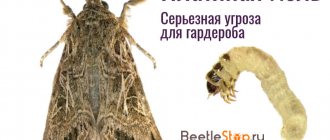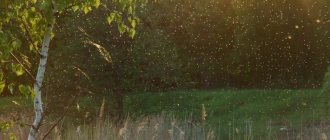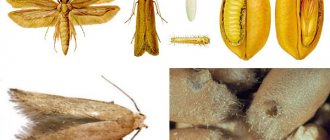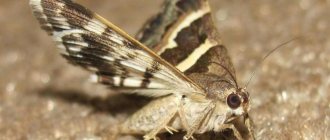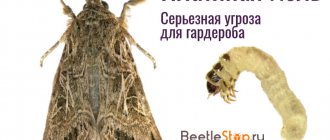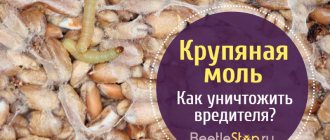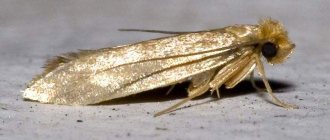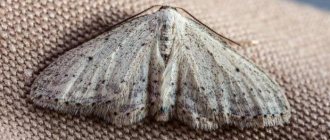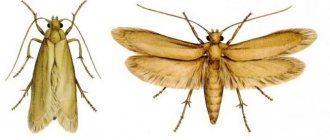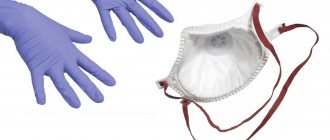The appearance of a nondescript gray butterfly in a house can cause real panic, because everyone knows that an insect can quickly cause irreparable damage to property. Every housewife should know how to get rid of moths and begin destroying them as quickly as possible so that they do not have to throw away damaged textiles or clothes.
An inconspicuous butterfly can cause a lot of damage
In this article we will talk about the harmful insect and how to get rid of it yourself at home.
Basic methods of fighting moths
There are many methods on how to get rid of moths. To eliminate pests, it is better to take an integrated approach. Disinsection involves thermal and chemical treatment, the use of folk remedies, as well as plants or oils with a distinct odor that repel parasites.
Heat treatment of the apartment
Lepidopteran parasites can exist at a certain temperature, in the range -5+45°C. When the indicators change, this will lead to the destruction of all offspring of pests.
How to fight moths in an apartment through heat treatment?
There are three effective ways to kill pests:
- steam exposure and washing items at high temperatures. The surface of carpets and furniture is treated with a steam generator or a household hair dryer turned on at high power.
- Exposure to low temperatures. In winter, open all doors and windows for several hours, which will destroy larvae, moth eggs and butterflies. Also, products made from natural fabric or fur are placed in freezers for a couple of hours.
Chemicals
The most effective method for removing moths from an apartment is the use of insecticides. But chemicals are quite dangerous to health, so when using such drugs it is important to follow a number of rules.
Most often, to get rid of moths, premises are treated with aerosols.
Effective sprays against parasites:
- Mosquitall moth protection – effective when processing fabrics, clothing, and furniture.
- Armol - quickly destroys insects living in wool and fur items.
- Clean Home is an effective, affordable remedy with a lavender aroma.
- Raptor - kills larvae and adults, has a residual effect in the first month of life and up to a year.
Like aerosols, fumigators are effective in the presence of winged parasites. These devices operate from mains power. When the device heats up, an insecticide evaporates from it, killing pests. Advantages of the fumigator - large affected area
Another way to destroy lepidopteran parasites is with pheromone traps. This is a small rectangular square of cardboard, soaked in the secretory substances of the female butterfly. The smell attracts males, who fly in and then stick to the trap.
Like traps, plates soaked in chemicals help get rid of winged parasites. Cardboard squares are placed in closets and other places where parasites accumulate. The effect of the plate lasts 2-3 months.
Professional exterminators
If there are a lot of moths, then extreme measures can be taken. To do this, you should call a pest control service. Professional companies have in their arsenal a lot of insecticides that eliminate any type of parasites.
When independent control of moths at home turns out to be ineffective, professional exterminators use cold or hot fog generators. These units deliver insecticides under pressure, so that the chemicals are evenly sprayed and penetrate into hard-to-reach places. This treatment allows you to destroy not only adult pests, but also larvae of pests.
Video
Moth control
Folk recipes
When moths appear in an apartment, how to eliminate them without using insecticides? Traditional recipes that are moderately effective but safer will help destroy winged pests.
Toilet or laundry soap is considered an effective remedy. The sticks need to be placed on the shelves of the wardrobe, or can be placed in the pockets of woolen clothes.
Homemade recipes:
- a handful of peels of any citrus fruits are poured with water (1 liter).
- Place the liquid on the fire and boil for 5 minutes.
- When the product has cooled, it is poured into a bottle, with a spray bottle screwed on top.
- The solution is used to treat floors, carpets, and shelves in closets.
Garlic will help get rid of moths at home. Vegetable slices are placed in places where insects are most concentrated.
Essential oils
Oil extracts will help get rid of moths in your clothes closet. After all, winged pests cannot tolerate strong odors.
Parasites are afraid of cedar, geranium, camphor, lavender, patchouli, and citrus oils. Hoods are used for wet cleaning. You can also drop a few drops of the extract onto paper or fabric napkins and place them in closets with clothes or in the pockets of things.
Plants
Effective and safe protection against moths at home is the use of herbs with a rich aroma that repels insects.
Plants that pests don't like:
- geranium;
- tansy;
- lavender;
- wild rosemary;
- sagebrush;
- rosemary;
- lemon balm;
- immortelle;
- thyme.
How to get rid of moths using herbs? You can prepare a decoction from the plants, which should be used to treat all surfaces or spray it on furniture and things. Dry herbs are also placed in wardrobes and closets where parasites live.
Other means
How and with what to remove moths from an apartment if the above-described means turned out to be ineffective. Few people know that butterflies are repelled by the smell of cedar. Twigs or pieces of wood can be placed in cabinets where things are stored.
Pests also don't like black pepper. Therefore, bags filled with peas are placed on shelves where fur and woolen products are located.
Grandmothers who have always used mothballs know how else to treat cabinets against moths. But it is a carcinogen and dangerous to health, which does not allow it to be used to eliminate food varieties of insects. It is recommended to place naphthalene in wardrobes with things.
Black moth, photo, signs
If the golden moth is familiar to everyone, then the black one can cause bewilderment. An unprepared person does not understand what to expect from her and what she is all about.
As a rule, such moths are food-grade and live in cereals and flour in the kitchen. Those pests that fly around the kitchen are mostly males. Female black moths are much lighter in color and prefer to incubate their eggs in a nutrient medium. The lifespan of an adult black moth is only a couple of weeks, and during this time it needs to have time to lay as many eggs as possible.
Like other representatives of this species, the black moth is divided into fruit, cereal and flour varieties. This affects the food preferences of the larvae. The eggs look like dusty cobwebs. Once hatched, the moth larvae resemble hairless white caterpillars with a black or brown head. Their length is slightly less than one centimeter, but with good nutrition they can grow up to two cm. The long white body of the larva has six false legs - one pair at the head, the rest along the body. Their jaws work so well that they are able to chew through not only the hard shell of food, but also bags and even foil.
Having hatched, they begin to bite into grains with roots or dried fruits in order to penetrate inside and continue their growth there. The larva develops within four or five weeks, easily processing and digesting food. If its habitat is warm and humid, it grows even faster.
Surrounded by a nutrient medium, they reach thirteen millimeters and pupate. The cocoons are light brown, made of cobwebs, ranging from six to thirteen centimeters in length. Eventually, an adult moth emerges from the cocoon. After release, food becomes secondary for her, and mating and laying eggs comes to the fore.
Its main danger is that it multiplies too quickly for the pest. If her stay in the house lasts for one or two months, all supplies will be spoiled. The presence of larvae in the cereal, in addition to the notorious “cobweb”, can be identified by the presence of dust from gnawed grains. In addition, they are detected by glued pieces of cobwebs and discarded skins.
According to signs, a black moth foreshadows the sudden and rapid death of one of the household members. This can happen within a month to a year.
Where do moths come from?
The reasons for the appearance of moths in the house can be varied. Often, the parasite larvae enter the home with contaminated food. The pest’s favorite food is sugar, nuts, cereals, dried fruits, flour, herbs, milk formula, and pet food.
How else can moths get into the house? Lepidoptera butterflies can fly into the room through ventilation structures. Sometimes parasite larvae are found in old library books.
Where do moths most often come from in an apartment? Insects can be brought into your home by purchasing fur products - clothes, shoes, carpets, furniture with natural upholstery.
A rare but probable method of moth entry is temporary parasitism of the insect on domestic animals. Although this is unlikely, because only adults can migrate in this way. Moreover, in order to exist, they need the shaggy and long hair of their pets.
Having learned how a moth ends up in a house, we can assume what conditions will be favorable for the existence of a butterfly:
- constant availability of food sources (dry herbs, cereals);
- twilight;
- absence of repulsive odors (citrus fruits, vinegar, tobacco, lavender);
- musty air.
An effective moth repellent
The leaders in the fight against moths are various fumigators. Due to the delayed action, this may not seem to be the case, but their pros far outweigh the cons. They are suitable as a preventative measure because they do not require constant monitoring or any effort on the part of a person. It is enough to turn them on in a room where a potential carrier of moth larvae will soon appear, and you can forget about them.
The fumigator can be used for a very long time - from several weeks to several months. When it runs out, you just need to change the wick and reuse it. Neither folk remedies nor Velcro sprays are designed for reuse.
Due to the extended exposure to moths, fumigators release significantly less insecticides into the air than sprays. This allows you to be in the same room with a working fumigator and practically does not lead to an allergic reaction. Fumigators are safe for children and animals, but direct contact with them is best avoided. The most popular fumigators are from Moskitol. A pleasant bonus of using them will be the absence of mosquitoes.
If after all the tricks the moths do not decrease, you should call a team of exterminators. This is the last and extremely radical remedy. Knowing everything about moths, from the ways in which they appear in the house to the variety of methods for getting rid of them, you can clean your apartment in the shortest possible time.
Types of moles
Moths are classified as keratophages, since the insect feeds on the horny substance found in the fur or wool. Some types of parasites can eat organic matter, because almost every plant has its own type of lepidopteran parasite.
There are dozens of types of moths living on the ground, and they can be large or small. Thus, there are wax moths, potato moths, furniture moths, fur moths, fruit moths, cabbage moths, grain kitchen moths and other interesting species.
Home
There are many varieties of lepidopteran insects. But most often, grain, clothes, fur, and furniture butterflies appear at home. These types differ in habitat, appearance, and nutrition.
Common types of house moths:
| Insect type | Description | Food | Habitat areas |
| Furniture | Size – up to 15 cm. Wing color – yellow-gray. The female can lay up to 300 eggs. | The favorite food of caterpillars is wool, natural fabrics, and furniture upholstery. | Interiors of upholstered furniture, warehouses of upholstered furniture. |
| Woolen or fur coat | The wings are yellow-gray with small dark dots, the lower part is lighter. The body of the insect is light. Wingspan – up to 16 mm. | Fur, wool, feathers, velvet, books, felt. | The moth lives in the closet where the fur clothes are located. |
| Clothes | The wingspan is up to 22 mm, the color is yellow with a purple tint. | Contaminated areas on things. | Dark cabinets containing cloth, silk, drape or cotton fabrics. |
| Cereal or food | The firebug has a wingspan of 10 mm. Its color is brown with stripes or gray with specks. | Cereals, legumes, nuts, herbs, flour, dry mixes. | A small moth lives in an apartment in kitchen cabinets where food products are located. |
street
Often moths enter an apartment from the street. Wood (poplar) moths often live in the city. This type of butterfly is harmless to humans; it feeds on leaves and poplar fluff.
Sometimes moths fly from the street if there is a field or vegetable garden near the house where potatoes, grain crops, tomatoes, cabbage, rowan or apple trees grow.
general information
House moth.
In general, the butterfly itself does not cause any harm. It reproduces offspring and provides them with the food necessary for life.
With the offspring, everything is not so simple: the eggs will turn into caterpillars and begin to engage in sabotage. Before getting rid of moths in the house, it will be necessary to combat all types of insect development, using various methods.
Moth caterpillars.
Answers to popular questions
There are a number of popular questions that interest apartment owners who have lepidopteran insects. So, many people want to know how to attract moths? Pheromone and glue traps will help attract parasites, attracting male clothes and food moths, which prevents their reproduction.
Where do moths hide in the apartment? If the insect feeds on natural fabrics, then its habitat will be dark closed wardrobes with wool and fur products. When a pest needs organic food, it will live in cabinets where cereals, dry herbs, and flour are located.
Can moths fly in from the street? A butterfly, like other insects, can enter a house from the street through a door or window that was open. Moreover, if there is a female in the dwelling, she will very quickly leave offspring, the breeding of which will require complex measures.
How to get divorced? The life process of an insect consists of a number of stages :
- appearance of larvae.
- Transformation of larvae into caterpillars.
- Development of pupae.
- The emergence of butterflies.
The female selects a male by smell. After mating, after 2-3 weeks, she can lay up to 350 eggs measuring up to 1 mm.
Moth larvae are actively growing and consuming a lot of food. After 35-50 days, the pupa emerges from the cocoon. After about 1 month, it becomes a butterfly capable of reproduction.
Lepidopterologists know how long moths live. Experts say that the life cycle of adult lepidopteran insects is 7-14 days.
Where do moths live in the house?
Depending on the species, moth habitats may vary.
- Clothes or clothes moth. There is a misconception that moths eat clothes and therefore prefer a certain type of item. This is wrong. Moths do not eat the material itself, but keratinized particles of dead skin that remain after wearing wardrobe items. This is why moths can be found not only on woolen outerwear, but also on pants, sweaters and fur coats. Moths prefer closed spaces, so it’s best to start looking for clothing pests in closets. In addition to the clothing itself, its larvae can be found in cracks and corners of its habitat. It is also better to check the laundry basket - moisture is not at all an obstacle to moth reproduction.
- Food moth. She lives where housewives store the most cereals and other supplies. Food moths love not only grains and cereals, but also dried fruits and even herbs with roots. Torn, poorly closed or damaged packaging is almost a guarantee that moth larvae have appeared in the products. If, upon inspection, these small worms are found in one jar or package, then you definitely need to review all stocks without exception. A spoiled product is no longer fit for consumption. As a preventive measure, it is recommended to store supplies in well-tightened jars and tightly tied bags.
Prevention
In order not to think about how to destroy winged pests, you should protect your home from their appearance. Thus, it is always necessary to examine all products brought from the store (cereals, flour, dried fruits, pet food) for the presence of butterfly larvae.
You should not stock up on food or dried herbs at home; it is important to periodically throw away expired, spoiled foods. It is advisable to store flour, herbs, and cereals in airtight jars.
It is equally important to inspect ventilation shafts, windows, doors, and cracks. If necessary, cover the entry points of insects with a fine mesh.
All woolen items must be aired periodically, and bags of lavender or geranium should be placed in the wardrobe where they are stored . Kitchen cabinets should be regularly ventilated, and shelves should be wiped with a vinegar solution.
A sign if there are moths in the house
In ancient times, the golden fluttering pest did not evoke good feelings among the population and its appearance was associated mainly with negative consequences. This was more than reasonable, since it started up mainly in spoiled food and dark, poorly ventilated rooms.
She was considered a harbinger:
- Unexpected cash costs. This followed from the fact that with the appearance of moths it was necessary to get rid of one of the few items of clothing or part of the winter supplies.
- A pale “butterfly” fluttering around the house was also a symbol of the inattention and aggression of one of the family members towards the others. With her appearance, they tried to bring a brawler or a heartless person to reason while there was still a chance to avoid a split in the relationship.
- A sudden and numerous invasion of moths was associated with the influence of dark forces or astral entities from the other world. It was believed that they were directed by enemies or envious people.
- The white moth was also a sad symbol. People believed that in the form of a moth the soul of the deceased returned home to visit his relatives. It was strictly forbidden to kill her, so as not to cause additional suffering to the soul of a loved one.
- If a moth appears suddenly and you cannot get rid of it, it means that the dark aspects of the consciousness of someone in the household have been activated. Small aspects of behavior could completely cross out all bright desires and aspirations.
- The appearance of a tiny fluttering pest could be evidence of magical damage being done, damage to the subconscious, which will only make itself felt if something extraordinary happens.
- If you come face to face with a moth, it means a letter will arrive soon.
Reasons for appearance
...food moth
Before you start listing the reasons why moths specifically begin to appear, as well as what the appearance of larvae will depend on, you should first go through the list of products, the availability and presence of which can attract such pests to your apartment. So, the food moth, or rather its larvae, love the following foods: spices, cereals, grains, pet food, flour products, cookies, dried fruits, baked goods, chocolate, sugar, tea, potatoes, coffee. As you can tell, food moth larvae can eat almost anything they can get their hands on. An exception may be spicy foods, for example, strong spices or garlic, and this is the only thing that will remain untouched by such voracious kitchen pests. And then we will list all the reasons that will help you understand why there are moths in the house and why insect butterflies and, over time, caterpillars may appear in the house.
The reasons are as follows:
- Introducing food moth larvae into the house along with food you bought at the store/market.
- Relocation of adult specific insects through the ventilation system from neighbors throughout the house.
- Attracting insects with excellent living conditions, the absence of strong aromas and maintaining dim light in the room.
- Butterflies entering an apartment through an open door or even a window.
It is immediately worth noting the fact that the statement that moths appear in the apartment only of unscrupulous people is a real fiction and stupidity.
Please note that in 4 out of 5 cases when an adult flying specimen of such an insect appears in your home, this is precisely the dishonesty of our manufacturers and sellers of products.
It is incorrect storage or non-compliance with certain storage conditions of the product and violation of the tightness of the packaging on the part of the manufacturer or even the distributor that will be an excellent chance for such insects to get inside to lay eggs and feed the larvae, which will definitely like a bag of dried fruit or a bag of buckwheat. . In addition, you should not turn off the possibility of such a small pest entering the house through a ventilation vent, or through the front door/windows. Here a slight tilt is made towards the window opening, because often the source of any insects entering an apartment (not just moths), because moths rarely get inside a human home through ventilation or a door, although this also cannot be ruled out.
Also, you should not leave a jar of sugar, a container with wheat or any other flour, or stocks of cereals open for a long time, thereby attracting insects. Here you can really blame the careless apartment owners who themselves invited pests into their homes. In addition, you need to periodically ventilate and allow sunlight to enter the room where all supplies are stored. Moths are not able to tolerate bright sunlight or drafts, so you should not allow a state of stagnation in your warehouse. Stuffy and dusty closets in the twilight with food will be a real paradise for food moths.
Why do clothes moths appear?
Next, we invite you to find out where exactly clothes moths appear in the house. Here, too, we should support the debunking of the myth about the insolvency of the owners if a pest such as a moth appears in the house. But more on the reasons later. To begin with, we should talk, as was decided earlier, about objects and food sources that can be perceived by wool moths as an excellent incubator for their own future offspring.
Clothes moths will prefer the following food sources, specifically:
- Items of clothing that are made from materials of natural origin, or more precisely from wool and fur.
- Furniture items made from natural cladding.
- Carpets made from real wool.
- Shoes containing natural wool fibers (felt boots, for example).
- Stuffed animals/birds.
Clothes moth larvae even eat synthetic materials and fabrics, but this can only happen if there is a shortage of natural raw materials, and to a greater extent only harms the caterpillars. While searching for natural fibers, such voracious creatures have a way of ruining even book bindings.
If there are a lot of moths at home from nowhere, then you should be concerned, since the damage that clothes moth caterpillars cause to human property is difficult to compare with the troubles that their “food” colleagues can cause. The sight of an expensive damaged fur coat, or furniture upholstery that has been chewed by insects, can give anyone a heart attack.
The reasons why such unfortunate pests appear in the house are as follows:
Moth larvae were found in purchased items of winter fur shoes or woolen clothing.- The pest caterpillars were transported along with old furniture that was in use.
- Entry into the house of larvae that have found temporary shelter in the fur of a pet.
Very often, the appearance of a piece of clothing in an apartment will indicate that it came to you along with recently purchased items that have replenished your wardrobe. And there are no guarantees when buying shoes or clothes even in the most expensive boutiques or branded stores. Such small pests are capable of laying eggs in items of clothing that are sold at a market stall or in an expensive boutique. Insects will not look at the logos and price tags of things; they are always looking only for the place where they will feel better.
Please note that there is a high probability of bringing butterfly larvae into the house along with purchased pieces of furniture, especially if you are buying used furniture.
Here we are talking about interior items that are equipped with natural upholstery. Although here, too, as with clothes, there is no guarantee that if you buy new furniture in a company store, there will be no eggs laid by moths on it. This is a matter of attentiveness and, to some extent, even luck. It is also very likely that such a pest will appear in the house through pets that have thick fur. Most types of cats and dogs have thick fur, and eggs of various insects can settle in its depths, which is why pests will be brought into the house along with the pet after walking.
Harm to humans
Most moth species are harmless to humans, as they feed on wood, fruits and other organic materials. Most species of these small animals pose a danger to agriculture because they feed on the nectar of flowers, plant sap and even their fruits.
There are species that prefer to feed on the blood of humans and other vertebrates. A striking example of such an insect is the vampire moth or vampire butterfly, which lives in Siberia and Scandinavia and has the ability to suck blood through human skin for 20 minutes. In addition, even harmless species of these insects in very rare cases can attack a person, leaving a small bite wound on his skin.
In addition to the listed species, there is a small family of moths within the order Lepidoptera butterflies, which, due to the presence of scales on the wings of its representatives, poses a risk of allergic reactions in sensitive people. For example, the flannel moth caterpillar or cat moth contains poisonous hairs on its body. When in contact with the human body, these villi can cause pain and rashes on the skin, and in severe cases, even lead to swelling of the limb, nausea and impaired respiratory function.
In the end, we must not forget that the existence of these insects poses a great risk to our hearth and to those who live in it. Most species feed on wood, so their activities can lead to the weakening and destruction of various structures made from this material, which increases the risk to human health.
What do food moths eat?
The food moth itself does not eat anything. Due to the underdevelopment of the food system, it can only consume water or other liquid - which is why it can often be found floating in a glass of water accidentally left on the table. But its larvae, or caterpillars, as they are also called, eat a lot of different foods. Actually, due to this they develop, subsequently passing through the stages of pupa and butterfly.
The nature of the food that species of food moths prefer to include in their “diet” can be guessed from their names given above. But everything is not as simple as it might seem at first glance. For example, the grain moth caterpillar, in addition to cereals and cocoa, will happily taste chocolate, dried fruits, tobacco and even medicinal herbs if it has access to all these delicacies. Other moths of this direction are similarly unpretentious in their preferences.
By the way, in the matter of food damage, the food moth has a competitor in the “face” of the clothes moth, whose caterpillar, in the absence of the usual provisions, will not disdain the gifts of someone else’s cuisine.
How moths start and what they eat
A moth is a very small insect (moth moth), but the damage it can cause to a farm cannot be called insignificant. The things and food supplies that its voracious larva feeds on cannot be enumerated. If we also add that one female is capable of laying more than one clutch of hundreds of eggs in her lifetime, then the scale of the disaster turns into a domestic catastrophe.
Carpets, fur coats, hats, socks, mittens, dresses and suits suffer, as well as flour, cereals, dried fruits, and nuts. It seems that this creature is omnivorous. There are more than 40 species of moths in nature, and each species eats something different.
Having discovered a flying monster, people are alarmed and begin to catch the butterfly. Which in itself is meaningless. The moth has already hatched somewhere in the depths of the cabinets and, besides it, there are probably hundreds of individuals there, ready to mate.
First of all, you need to determine what type of moth you have in your house and what it feeds on. After this, the search for contaminated areas is narrowed and methods of destruction are selected.
Moths do not only appear in places where there is unsanitary conditions. We can bring a pupa or larva on a coat, fur coat, fur trim of a shoe, or on any fleecy natural item. Even on the fur pompom of your favorite hat. A tenacious and voracious creature finds secluded places in the house where it has something to eat and is ready: you have a moth in your house.
As soon as you neglect the seasonal cleaning of wearables: airing, drying in the sun and placing moth repellents, the likelihood of a flying disaster increases significantly. Moth-eaten carpets and furs are not uncommon in homes where there is dampness and little light. Or they are rarely taken out into the air for weathering, frying and beating.
All our clothing containing wool or natural fibers is under threat of destruction from moths. She is affected by clothes moths. It is also called wool, fur coat, felt or felt. It also “beats” cotton clothes (usually in dirty places: cuffs, under the collar); and mixed fabrics containing wool.
Timely general inspections of cabinets, ventilation and frying in the sun are the best protection against moths.
As for food moths, we ourselves bring in infested bags of cereals and flour from stores. Most often, these are those whose shelf life is approaching the end. Then retail chains put them on sale at significant discounts. And we rejoice at the dubious savings and bring this infection into the house.
Even if you examine each package without leaving the store shelf, it is difficult to immediately discern contaminated grains. At home, the nest will increase in size, the larvae will pupate, gnaw through the packaging and fly off in search of a mate. You will see the pest already flying around the kitchen, if you did not notice it earlier in the form of swarming worms. This is food moth, which is also called grain, fruit, rye.
Bottom line
Moths are harmful and tenacious insects. If it is not possible to prevent the appearance, then destruction is carried out by a combination of methods. Food products that have been infested with larvae should absolutely not be eaten, since waste products of caterpillars and their remains can cause allergies and poisoning.
Previous
Moth24 best remedies for moths in the apartment and house: we destroy and carry out prevention
Next
Apartment and houseRat in the toilet: a terrible reality or an invented threat
